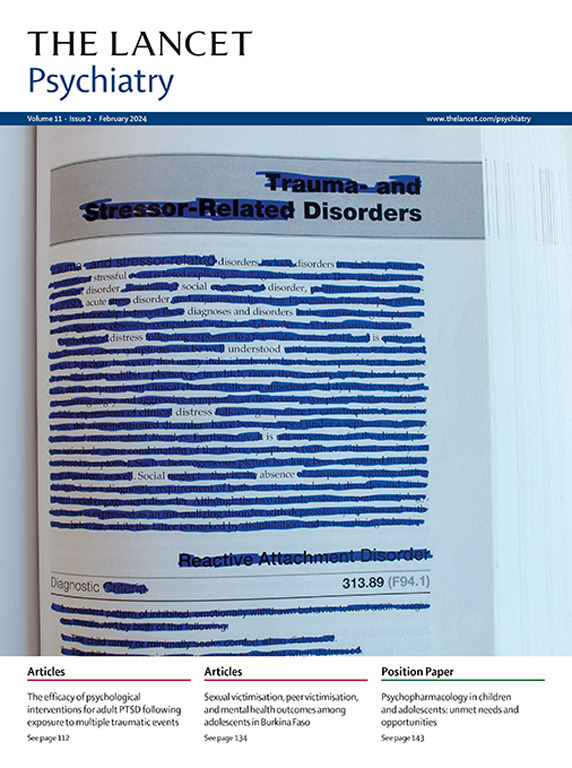Clinical and cost-effectiveness of lithium versus quetiapine augmentation for treatment-resistant depression: a pragmatic, open-label, parallel-group, randomised controlled superiority trial in the UK
IF 30.8
1区 医学
Q1 PSYCHIATRY
引用次数: 0
Abstract
Background
Lithium and quetiapine are first-line augmentation options for treatment-resistant depression; however, few studies have compared them directly, and none for longer than 8 weeks. We aimed to assess whether quetiapine augmentation therapy is more clinically effective and cost-effective than lithium for patients with treatment-resistant depression over 12 months.Methods
We did this pragmatic, open-label, parallel-group, randomised controlled superiority trial at six National Health Service trusts in England. Eligible participants were adults (aged ≥18 years) with a current episode of major depressive disorder meeting DSM-5 criteria, with a score of 14 or higher on the 17-item Hamilton Depression Rating Scale at screening who had responded inadequately to two or more therapeutic antidepressant trials. Exclusion criteria included having a diagnosis of bipolar disorder or current psychosis. Participants were randomly assigned (1:1) to the decision to prescribe lithium or quetiapine, stratified by site, depression severity, and treatment resistance, using block randomisation with randomly varying block sizes. After randomisation, pre-prescribing safety checks were undertaken as per standard care before proceeding to trial medication initiation. The coprimary outcomes were depressive symptom severity over 12 months, measured weekly using the Quick Inventory of Depressive Symptomatology, and time to all-cause treatment discontinuation. Economic analyses compared the cost-effectiveness of the two treatments from both an NHS and personal social services perspective, and a societal perspective. Primary analyses were done in the intention-to-treat population, which included all randomly assigned participants. People with lived experience were involved in the trial. The trial is completed and registered with the International Standard Randomised Controlled Trial registry, ISRCTN16387615.Findings
Between Dec 5, 2016, and July 26, 2021, 212 participants (97 [46%] male gender and 115 [54%] female gender) were randomly assigned to the decision to prescribe quetiapine (n=107) or lithium (n=105). The mean age of participants was 42·4 years (SD 14·0 years) and 188 (89%) of 212 participants were White, seven (3%) were of mixed ethnicity, nine (4%) participants were Asian, four (2%) were Black, three (1%) were of Other ethnicity, and ethnicity was not recorded for one (1%) participant. Participants in the quetiapine group had a significantly lower overall burden of depressive symptom severity than participants in the lithium group (area under the between-group differences curve –68·36 [95% CI –129·95 to –6·76; p=0·0296). Time to discontinuation did not significantly differ between the two groups. Quetiapine was more cost-effective than lithium. 32 serious adverse events were recorded in 18 participants, one of which was deemed possibly related to the trial medication in a female participant in the lithium group. The most common serious adverse event was overdose, occurring in three (3%) of 107 participants in the quetiapine group (seven events) and three (3%) of 105 participants in the lithium group (five events).Interpretation
Results of the trial suggest that quetiapine is more clinically effective than lithium as a first-line augmentation option for reducing symptoms of depression in the long-term management of treatment-resistant depression, and is probably more cost-effective than lithium.Funding
National Institute for Health and Care Research Health Technology Assessment programme.锂与喹硫平增强治疗难治性抑郁症的临床和成本效益:英国一项实用、开放标签、平行组、随机对照的优势试验
背景:锂和喹硫平是治疗难治性抑郁症的一线辅助选择;然而,很少有研究直接比较它们,也没有超过8周的研究。我们的目的是评估喹硫平增强治疗是否比锂治疗在12个月以上的难治性抑郁症患者的临床效果和成本效益更高。方法我们在英国6个国家卫生服务信托机构进行了这项实用、开放标签、平行组、随机对照的优势试验。符合条件的参与者为成人(年龄≥18岁),当前有重度抑郁症发作,符合DSM-5标准,在17项汉密尔顿抑郁评定量表中得分为14分或更高,对两项或更多治疗性抗抑郁药物试验反应不充分。排除标准包括诊断为双相情感障碍或当前精神病。参与者被随机分配(1:1)决定开锂或喹硫平,按部位、抑郁严重程度和治疗耐药性分层,使用随机变化块大小的块随机化。随机化后,在开始试验用药前按照标准护理进行处方前安全检查。主要结局是12个月的抑郁症状严重程度,每周使用抑郁症状快速量表测量,以及停止全因治疗的时间。经济分析从国民保健制度和个人社会服务的角度以及社会的角度比较了两种治疗的成本效益。在意向治疗人群中进行了初步分析,包括所有随机分配的参与者。有生活经验的人参与了试验。该试验已完成并在国际标准随机对照试验注册中心ISRCTN16387615注册。在2016年12月5日至2021年7月26日期间,212名参与者(97名[46%]男性和115名[54%]女性)被随机分配到决定开喹硫平(n=107)或锂(n=105)。参与者的平均年龄为42.4岁(SD 14.0岁),212名参与者中有188名(89%)为白人,7名(3%)为混合种族,9名(4%)为亚洲人,4名(2%)为黑人,3名(1%)为其他种族,1名(1%)参与者的种族未记录。喹硫平组受试者抑郁症状严重程度的总体负担显著低于锂组受试者(组间差异曲线下面积- 68.36 [95% CI - 129.95 ~ - 6.76;p = 0·0296)。停药时间在两组间无显著差异。喹硫平比锂更具成本效益。在18名参与者中记录了32例严重不良事件,其中一例被认为可能与锂组中一名女性参与者的试验药物有关。最常见的严重不良事件是过量,喹硫平组107名参与者中有3名(3%)发生(7次事件),锂组105名参与者中有3名(3%)发生(5次事件)。该试验结果表明,在治疗难治性抑郁症的长期治疗中,喹硫平作为减轻抑郁症状的一线增强选择在临床上比锂更有效,并且可能比锂更具成本效益。资助国家卫生和保健研究所卫生技术评估方案。
本文章由计算机程序翻译,如有差异,请以英文原文为准。
求助全文
约1分钟内获得全文
求助全文
来源期刊

Lancet Psychiatry
PSYCHIATRY-
CiteScore
58.30
自引率
0.90%
发文量
0
期刊介绍:
The Lancet Psychiatry is a globally renowned and trusted resource for groundbreaking research in the field of psychiatry. We specialize in publishing original studies that contribute to transforming and shedding light on important aspects of psychiatric practice. Our comprehensive coverage extends to diverse topics including psychopharmacology, psychotherapy, and psychosocial approaches that address psychiatric disorders throughout the lifespan. We aim to channel innovative treatments and examine the biological research that forms the foundation of such advancements. Our journal also explores novel service delivery methods and promotes fresh perspectives on mental illness, emphasizing the significant contributions of social psychiatry.
 求助内容:
求助内容: 应助结果提醒方式:
应助结果提醒方式:


